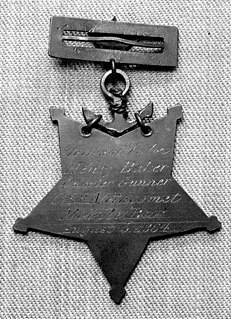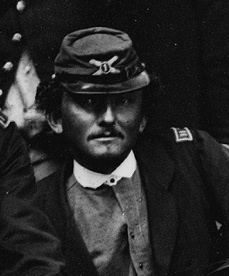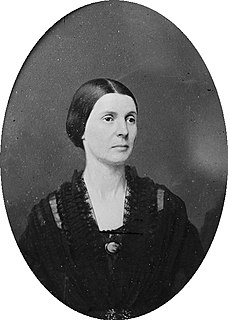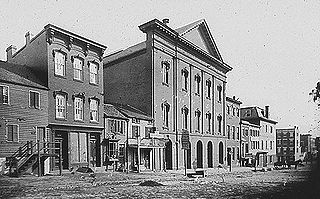 W
WGeorge Mifflin Bache, Jr. was an officer in the United States Navy, fighting on the Union side in the American Civil War and continuing to serve for a decade after the war's end. The Fletcher-class destroyer USS Bache (DD-470) was named for him.
 W
WCharles Baker, also known as Henry Baker, was a Union Navy sailor in the American Civil War and a recipient of the U.S. military's highest decoration, the Medal of Honor, for his actions at the Battle of Mobile Bay.
 W
WLafayette Curry Baker was a United States investigator and spy, serving the Union Army, during the American Civil War and under Presidents Abraham Lincoln and Andrew Johnson.
 W
WMathew B. Brady was one of the earliest photographers in American history. Best known for his scenes of the Civil War, he studied under inventor Samuel F. B. Morse, who pioneered the daguerreotype technique in America. Brady opened his own studio in New York in 1844, and photographed Andrew Jackson, John Quincy Adams, and Abraham Lincoln, among other public figures.
 W
WJohn Milton Brannan was a career American Army officer who served in the Mexican–American War and as a Union general in the American Civil War, in command of the Department of Key West in Florida and assigned to Fort Zachary Taylor. His first wife was the daughter of Colonel Ichabod Crane; she mysteriously disappeared after taking a ferry from Staten Island to Lower Manhattan and was presumed to have been murdered.
 W
WCornelius Scranton Bushnell was an American railroad executive and shipbuilder who was instrumental in developing ironclad ships for the Union Navy during the American Civil War.
 W
WAdolf Ludwig Cluss also known as Adolph Cluss was a German-born American immigrant who became one of the most important, influential and prolific architects in Washington, D.C., in the late 19th century, responsible for the design of numerous schools and other notable public buildings in the capital. Today, several of his buildings are still standing. He was also a City Engineer and a Building Inspector for the Board of Public Works.
 W
WJohn Early was an Irish-American Catholic priest and Jesuit educator who was the president of the College of the Holy Cross and Georgetown University, as well as the founder and first president of Loyola College in Maryland. Born in Ireland, he emigrated to the United States at the age of nineteen. Upon his arrival, he enrolled at Mount St. Mary's Seminary in Maryland, and entered the Society of Jesus, completing his education at Georgetown University in Washington, D.C.
 W
WRichard Stoddert Ewell was a career United States Army officer and a Confederate general during the American Civil War. He achieved fame as a senior commander under Stonewall Jackson and Robert E. Lee and fought effectively through much of the war, but his legacy has been clouded by controversies over his actions at the Battle of Gettysburg and at the Battle of Spotsylvania Court House.
 W
WManning Ferguson Force was a lawyer, judge, and soldier from Ohio. He became known as the commander of the 20th Ohio Volunteer Infantry in the Union Army during the American Civil War, and was a recipient of the Army Medal of Honor for gallantry in action.
 W
WGeorge Washington Getty was a career military officer in the United States Army, most noted for his role as a division commander in the Army of the Potomac during the final full year of the American Civil War.
 W
WCommodore John R. Goldsborough was an officer in the United States Navy. Goldsborough was made a cadet-midshipman in 1824 and as such saw action in the Mediterranean against pirates. In one incident, while in charge of 18 men he attacked and captured a Greek pirate ship with a 58-man crew.
 W
WLouis Malesherbes Goldsborough was a rear admiral in the United States Navy during the American Civil War. He held several sea commands during the Civil War, including that of the North Atlantic Blockading Squadron. He was also noted for contributions to nautical scientific research.
 W
WWilliam Montrose Graham was a career soldier in the United States Army, reaching the rank of major general. He was a veteran of both the American Civil War and the Spanish–American War.
 W
WRose O'Neal Greenhow was a renowned Confederate spy during the American Civil War. A socialite in Washington, D.C., during the period before the war, she moved in important political circles and cultivated friendships with presidents, generals, senators, and high-ranking military officers including John C. Calhoun and James Buchanan. She used her connections to pass along key military information to the Confederacy at the start of the war. In early 1861, she was given control of a pro-Southern spy network in Washington, D.C., by her handler, Thomas Jordan, then a captain in the Confederate Army. She was credited by Jefferson Davis, the Confederate president, with ensuring the South's victory at the First Battle of Bull Run in late July 1861.
 W
WDavid Edgar Herold was an accomplice of John Wilkes Booth in the assassination of Abraham Lincoln on April 14, 1865. After the shooting, Herold accompanied Booth to the home of Dr. Samuel Mudd, who set Booth's injured leg. The two men then continued their escape through Maryland and into Virginia, and Herold remained with Booth until the authorities cornered them in a barn. Herold surrendered, but Booth was shot and died two hours later. Herold was sentenced to death and hanged with three other conspirators at the Washington Arsenal, now known as Fort Lesley J. McNair.
 W
WJoseph Holt was an American lawyer, soldier, and politician. As a leading member of the Buchanan administration, he succeeded in convincing Buchanan to oppose the secession of the South. He returned to Kentucky and successfully battled the secessionist element thereby helping to keep Kentucky in the Union. President Abraham Lincoln appointed him the Judge Advocate General of the United States Army. He served as Lincoln's chief arbiter and enforcer of military law, and supporter of emancipation. His most famous roles came in the Lincoln assassination trials.
 W
WEmily Howland was a philanthropist and educator. Especially known for her activities and interest in the education of African-Americans, she was also a strong supporter of women's rights and the temperance movement. Howland personally financed the education of many black students and contributed to institutions such as the Tuskegee Institute.
 W
WTheodore Frelinghuysen Jewell was a rear admiral of the United States Navy.
 W
WWilliam Henry Johnson was a free African American and the personal valet of Abraham Lincoln. Having first worked for Lincoln in Springfield, Illinois, Johnson accompanied the President-Elect to Washington, D.C. for his first inauguration (1861).
 W
WHoratio King was Postmaster General of the United States under James Buchanan.
 W
WJohn Lenthall was an important American shipbuilder and naval architect. He was responsible for the construction and repair of United States Navy ships during the American Civil War (1861–1865), as well as in the years immediately before and after it. His career spanned the U.S. Navy's transition from sail to steam propulsion and from wooden ships to ironclads, and in retirement he participated in early planning for an eventual steel navy.
 W
WCaptain Robert F. R. Lewis was an officer in the United States Navy. He participated in the Paraguay Expedition, fought in the Mexican War and American Civil War, and served briefly as commander of the Asiatic Squadron.
 W
WMansfield Lovell was a major general in the Confederate States Army during the American Civil War. As military commander of New Orleans when the city unexpectedly fell to the Union Navy in 1862, Lovell was fiercely criticized by local citizens for failing to predict a naval invasion. The Confederate government also heaped blame on him, to deflect attention from their own error in leaving so few troops to defend the city. A Court of Enquiry later cleared him of charges of incompetence, but his reputation never recovered.
 W
WWashington Matthews was a surgeon in the United States Army, ethnographer, and linguist known for his studies of Native American peoples, especially the Navajo.
 W
WEdward Maynard was an American firearms inventor, most famous for his breechloading rifle design.
 W
WJohn Rodgers Meigs was an officer in the Union Army during the American Civil War. He was the son of Brigadier General Montgomery C. Meigs, the Quartermaster General of the United States Army. He participated in the First Battle of Bull Run, and later testified in the court-martial trial of an officer involved in the retreat from the battle. He attended the United States Military Academy, where he was an acting assistant professor of mathematics and graduated first in his class in June 1863. He was lauded by Secretary of War Edwin M. Stanton for strengthening the defenses of Baltimore, Maryland; was an engineer and acting aide-de-camp on the staff of Brigadier General (Volunteers) William W. Averell; was Chief Engineer of the Shenandoah Valley for the Department of West Virginia; and was Chief Engineer of the Middle Military Division and aide-de-camp to General Phillip Sheridan. The circumstances under which Meigs died led to the burning of Dayton, Virginia, in retaliation. His funeral was a public event attended by President Abraham Lincoln, Stanton, and numerous government dignitaries. A book of Meigs' letters were published in 2006 under the title A Civil War Soldier of Christ and Country: The Selected Correspondence of John Rodgers Meigs, 1859-64.
 W
WMontgomery Cunningham Meigs was a career United States Army officer and civil engineer, who served as Quartermaster General of the U.S. Army during and after the American Civil War. Meigs strongly opposed secession and supported the Union; his record as Quartermaster General was regarded as outstanding, both in effectiveness and in ethical probity, and Secretary of State William H. Seward viewed it as a key factor in the Union victory.
 W
WWilliam W. Morrow was a United States Representative from California, a United States District Judge of the United States District Court for the Northern District of California and a United States Circuit Judge of the United States Court of Appeals for the Ninth Circuit and the United States Circuit Courts for the Ninth Circuit.
 W
WRear Admiral Reginald Fairfax Nicholson was an officer in the United States Navy. He fought in the American Civil War and Spanish–American War, was Commander-in-Chief of the United States Asiatic Fleet, and came out of retirement during World War I to serve as the first U.S. naval attaché to Ecuador and Peru. He retired as the last active-duty U.S. Navy officer to have served in the American Civil War.
 W
WAlfred Pleasonton was a United States Army officer and major general of volunteers in the Union cavalry during the American Civil War. He commanded the Cavalry Corps of the Army of the Potomac during the Gettysburg Campaign, including the largest predominantly cavalry battle of the war, Brandy Station. In 1864, he was transferred to the Trans-Mississippi Theater, where he defeated Confederate General Sterling Price in two key battles, including the Battle of Mine Creek, the second largest cavalry battle of the war, effectively ending the war in Missouri. He was the son of Stephen Pleasonton and younger brother of Augustus Pleasonton.
 W
WWilliam Nathaniel Roach was a United States Senator from North Dakota.
 W
WAlbin Francisco Schoepf was a Polish-born artillery officer who became a Union brigadier general during the American Civil War. Obtaining professional military training in Austria, Schoepf briefly fought in the Austrian Army, then served as an officer in the Hungarian Revolutionary Army in the Hungarian Revolution of 1848. Schoepf came to America after his service, lived in Washington, D.C. and worked in various United States government bureaucratic positions before the Civil War. Appointed Union Army brigadier in late 1861, Schoepf was eventually raised to division command in the Western Theater. Personal conflicts with his commanding officer caused his transfer to administrative service in the East. Given command of the camp at Fort Delaware, Schoepf became responsible for Confederate prisoners of war. After the war, he returned to government service in the U.S. Patent Office.
 W
WThomas Jenkins Semmes was an American politician who served as a Confederate States Senator from Louisiana from 1862 to 1865. He was once described as "the most distinguished statesman and brilliant lawyer of the south." He was the 9th president of the American Bar Association 1886-1887.
 W
WAlexander Robey Shepherd, was one of the most controversial and influential civic leaders in the history of Washington, D.C., and one of the most powerful big-city political bosses of the Gilded Age. He was head of the DC Board of Public Works from 1871 to 1873 and Governor of the District of Columbia from 1873 to 1874. He is known, particularly in Washington, as "The Father of Modern Washington."
 W
WCaleb Blood Smith was a United States Representative from Indiana, the 6th United States Secretary of the Interior and a United States District Judge of the United States District Court for the District of Indiana.
 W
WEdman "Ned" Spangler was an American carpenter and stagehand who was employed at Ford's Theatre at the time of President Abraham Lincoln's murder on April 14, 1865. He and seven others were charged in conspiring to assassinate Lincoln and three other high level government officials. Spangler was the only one found not guilty of the conspiracy charge. Even so, he was found guilty of helping Lincoln's assassin, John Wilkes Booth, escape and sentenced to six years of hard labor.
 W
WHoratio Stone, was an American sculptor, physician and writer. He is best remembered for his three statues in the U.S. Capitol.
 W
WJohn Harrison Surratt Jr. was accused of plotting with John Wilkes Booth to kidnap U.S. President Abraham Lincoln; he was also suspected of involvement in the Abraham Lincoln assassination. His mother, Mary Surratt, was convicted of conspiracy and hanged by the U.S. government; she owned the boarding house that the conspirators used as a safe house and to plot the scheme.
 W
WJames Theodore Talbot was an American officer and explorer during the 19th century.
 W
WPeter Taltavull played a minor role in the events surrounding the assassination of Abraham Lincoln. John Wilkes Booth stopped at Taltavull's Star Saloon just before going to Ford's Theatre next door and assassinating President Abraham Lincoln.
 W
WHenry "Harry" Clay Taylor was a rear admiral in the United States Navy who served in the American Civil War and the Spanish–American War. He also served as Chief of the Bureau of Navigation and President of the Naval War College.